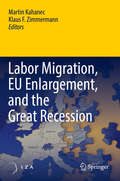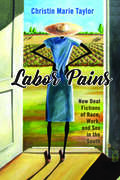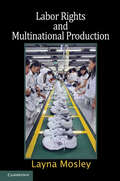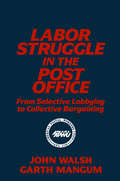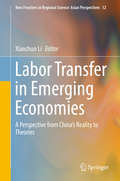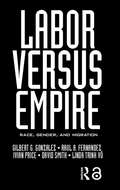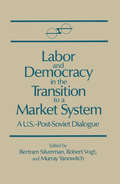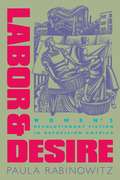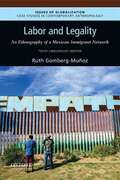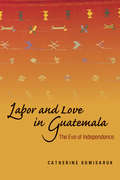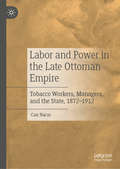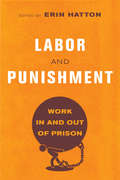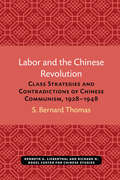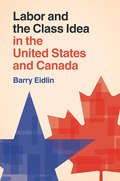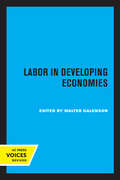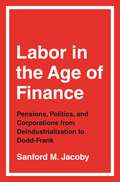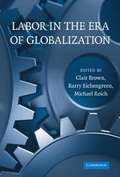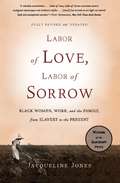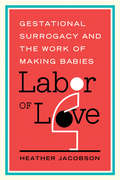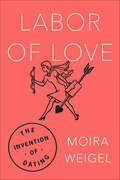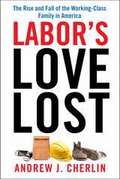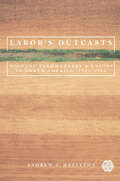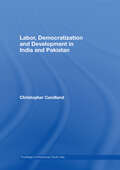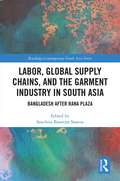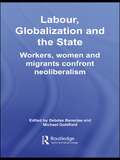- Table View
- List View
Labor Migration, EU Enlargement, and the Great Recession
by Martin Kahanec Klaus F. ZimmermannThis volume extends and deepens our knowledge about cross-border mobility and its role in an enlarged EU. More specifically, its main purpose is to enlighten the growing and yet rather uninformed debate about the role of post-enlargement migration for economic adjustment in the crisis-stricken labor markets of the Eurozone and the EU as a whole. The book addresses the political economy aspects of post-enlargement migration, including its broader political contexts, redistributive impacts, but also nationalization of the enlargement agenda. It also covers the experience of receiving and sending countries with post-enlargement migration and its role during the current crisis. Renowned experts in the field study, whether and how post-enlargement mobility has enabled the EU to absorb asymmetric economic shocks, how it has affected the European welfare systems, and whether it has contributed to the sustainability of the Eurozone. The authors also evaluate brain circulation as a sought-after vehicle of improved allocative efficiency of EU labor markets and propose a policy agenda for mobility in an enlarged EU.
Labor Pains: New Deal Fictions of Race, Work, and Sex in the South (Margaret Walker Alexander Series in African American Studies)
by Christin Marie TaylorFrom the 1930s to the 1960s, the Popular Front produced a significant era in African American literary radicalism. While scholars have long associated the black radicalism of the Popular Front with the literary Left and the working class, Christin Marie Taylor considers how black radicalism influenced southern fiction about black workers, offering a new view of work and labor.At the height of the New Deal era and its legacies, Taylor examines how southern literature of the Popular Front not only addressed the familiar stakes of race and labor but also called upon an imagined black folk to explore questions of feeling and desire. By poring over tropes of black workers across genres of southern literature in the works of George Wylie Henderson, William Attaway, Eudora Welty, and Sarah Elizabeth Wright, Taylor reveals the broad reach of black radicalism into experiments with portraying human feelings.These writers grounded interrelationships and stoked emotions to present the social issues of their times in deeply human terms. Taylor emphasizes the multidimensional use of the sensual and the sexual, which many protest writers of the period, such as Richard Wright, avoided. She suggests Henderson and company used feeling to touch readers while also questioning and reimagining the political contexts and apparent victories of their times. Taylor shows how these fictions adopted the aesthetics and politics of feeling as a response to New Deal–era policy reforms, both in their successes and their failures. In effect, these writers, some who are not considered a part of an African American protest tradition, illuminated an alternative form of protest through poignant paradigms.
Labor Rights and Multinational Production
by Layna MosleyLabor Rights and Multinational Production investigates the relationship between workers' rights and multinational production. Mosley argues that some types of multinational production, embodied in directly owned foreign investment, positively affect labor rights. But other types of international production, particularly subcontracting, can engender competitive races to the bottom in labor rights. To test these claims, Mosley presents newly generated measures of collective labor rights, covering a wide range of low- and middle-income nations for the 1985–2002 period. Labor Rights and Multinational Production suggests that the consequences of economic openness for developing countries are highly dependent on foreign firms' modes of entry and, more generally, on the precise way in which each developing country engages the global economy. The book contributes to academic literature in comparative and international political economy, and to public policy debates regarding the effects of globalization.
Labor Struggle in the Post Office: From Selective Lobbying to Collective Bargaining (Labor And Human Resources)
by John Walsh Garth L. MangumUsing data from the 2000 Census, this collection examines the major demographic and employment trends in the rural Midwestern states with special attention to the issues that state and local policy makers must address in the near future.
Labor Transfer in Emerging Economies
by Xiaochun LiBased on new phenomena appearing in many emerging economies, this book presents a theoretical study on the economic influences of labor transfer from several aspects. In recent years, thanks to the continuous progress of social forms as well as science and technology, there are a large number of new developing trends in emerging nations. Taking China as an example, several economic issues have sprung up with the huge scale of labor transfer, such as development of modern agriculture, environmental protection, privatization of mixed enterprises, training of human capital, and migrant workers' remittances to their hometowns. However, the existing researches on labor transfer pay little attention to them. In order to bridge the gap, this book combines new economic data with basic theories of labor migration, and discusses economic influences of labor transfer in four angles: human capital, migrants' remittances, environmental protection, and development of modern agriculture. Each part is composed of two or three analytical elements. Our conclusions not only enrich existing theoretical researches, but also provide theoretical support for related national economic policies.
Labor Versus Empire: Race, Gender, Migration
by David Smith Gilbert G. Gonzalez Linda Trinh Võ Raul A. Fernandez Vivian PriceThe essays in this collection address issues significant to labor within regional, national and international contexts. Themes of the chapters will focus on managed labor migration; organizing in multi-ethnic and multi-national contexts; global economics and labor; global economics and inequality; gender and labor; racism and globalization; regional trade agreements and labor.
Labor and Democracy in the Transition to a Market System
by Bertram Silverman Robert Vogt Murray YanovichNowhere is the tension attending simultaneous political democratization and economic liberalization more sharply felt than in the realm of labour relations. What is happening in Soviet trade unions today? How will the emerging independent unions respond to anticipated rises in unemployment? What kind of social regulation of the labour market will be appropriate in the future? These papers from a pathbreaking US-Soviet conference on labour issues reveal a considerable diversity of views on questions whose resolution will be essential to social peace in this period of transition. Among the noted contributors are Joseph Berliner, Sam Bowles, Richard Freeman, Leonid Gordon, V.L.Kosmarskii, Alla Nazimova, Michael Piore, Boris Rakitskii, Iurii Volkov, Ben Ward and Tatiana Zaslavskaia.
Labor and Desire
by Paula RabinowitzThis critical, historical, and theoretical study looks at a little-known group of novels written during the 1930s by women who were literary radicals. Arguing that class consciousness was figured through metaphors of gender, Paula Rabinowitz challenges the conventional wisdom that feminism as a discourse disappeared during the decade. She focuses on the ways in which sexuality and maternity reconstruct the "classic" proletarian novel to speak about both the working-class woman and the radical female intellectual.Two well-known novels bracket this study: Agnes Smedley's Daughters of Earth (1929) and Mary McCarthy's The Company She Keeps (1942). In all, Rabinowitz surveys more than forty novels of the period, many largely forgotten. Discussing these novels in the contexts of literary radicalism and of women's literary tradition, she reads them as both cultural history and cultural theory. Through a consideration of the novels as a genre, Rabinowitz is able to theorize about the interrelationship of class and gender in American culture.Rabinowitz shows that these novels, generally dismissed as marginal by scholars of the literary and political cultures of the 1930s, are in fact integral to the study of American fiction produced during the decade. Relying on recent feminist scholarship, she reformulates the history of literary radicalism to demonstrate the significance of these women writers and to provide a deeper understanding of their work for twentieth-century American cultural studies in general.
Labor and Legality: An Ethnography of a Mexican Immigrant Network, 10th Anniversary Edition (Issues of Globalization:Case Studies in Contemporary Anthropology)
by Ruth Gomberg-MuñozLabor and Legality: An Ethnography of a Mexican Immigrant Network, Tenth Anniversary Edition, is an ethnography of undocumented immigrants who work as busboys at a Chicago-area restaurant. Ruth Gomberg-Muñoz introduces readers to the Lions, ten friends from Mexico committed to improving their fortunes and the lives of their families. Set in and around "Il Vino," a restaurant that could stand in for many places that employ undocumented workers, The Tenth Anniversary Edition of Labor and Legality reveals the faces behind the war being waged over "illegal immigrants" in America. Gomberg-Muñoz focuses on how undocumented workers develop a wide range of social strategies to cultivate financial security, nurture emotional well-being, and promote their dignity and self-esteem. She also reviews the political and historical circumstances of undocumented migration, with an emphasis on post-1970 socioeconomic and political conditions in the United States and Mexico. <P><P>Labor and Legality, Tenth Anniversary Edition, is one of many volumes in the series ISSUES OF GLOBALIZATION: CASE STUDIES IN CONTEMPORARY ANTHROPOLOGY, which introduces key concepts and theories of globalization through rich and compelling ethnography. It offers new research through case studies in a style and format appropriate for both students and scholars of Anthropology and related fields. Each volume offers a brief and engaging exploration of a particular issue arising from globalization and its cultural, political, and economic effects on certain peoples or groups.
Labor and Love in Guatemala: The Eve of Independence
by Catherine KomisarukLabor and Love in Guatemalare-envisions the histories of labor and ethnic formation in Spanish America. Taking cues from gender studies and the "new" cultural history, the book transforms perspectives on the major social trends that emerged across Spain's American colonies: populations from three continents mingled; native people and Africans became increasingly hispanized; slavery and other forms of labor coercion receded. Komisaruk's analysis shows how these developments were rooted in gendered structures of work, migration, family, and reproduction. The engrossing narrative reconstructs Afro-Guatemalan family histories through slavery and freedom, and tells stories of native working women and men based on their own words. The book takes us into the heart of sweeping historical processes as it depicts the migrations that linked countryside to city, the sweat and filth of domestic labor, the rise of female-headed households, and love as it was actually practiced—amidst remarkable permissiveness by both individuals and the state.
Labor and Power in the Late Ottoman Empire: Tobacco Workers, Managers, and the State, 1872–1912
by Can NacarBy the early twentieth century, consumers around the world had developed a taste for Ottoman-grown tobacco. Employing tens of thousands of workers, the Ottoman tobacco industry flourished in the decades between the 1870s to the First Balkan War—and it became the locus of many of the most active labor struggles across the empire. Can Nacar delves into the lives of these workers and their fight for better working conditions. Full of insight into the changing relations of power between capital and labor in the Ottoman Empire and the role played by state actors in these relations, this book also draws on a rich array of primary sources to foreground the voices of tobacco workers themselves.
Labor and Punishment: Work in and out of Prison
by Erin HattonThe insightful chapters in this volume reveal the multiple and multifaceted intersections between mass incarceration and neoliberal precarity. Both mass incarceration and the criminal justice system are profoundly implicated in the production and reproduction of the low-wage "exploitable" precariat, both within and beyond prison walls. The carceral state is a regime of labor discipline—and a growing one—that extends far beyond its own inmate labor. This regime not only molds inmates into compliant workers willing and expected to accept any "bad" job upon release but also compels many Americans to work in such jobs under threat of incarceration, all the while bolstering their "exploitability" and socioeconomic marginality. Contributors include Anne Bonds, Philip Goodman, Amanda Bell Hughett, Caroline M. Parker, Gretchen Purser, Jacqueline Stevens, and Noah D. Zatz.
Labor and the Chinese Revolution: Class Strategies and Contradictions of Chinese Communism, 1928–1948 (Michigan Monographs In Chinese Studies #49)
by S. Bernard ThomasIn the two-decade period from 1928 to 1948, the proletarian themes and issues underlying the Chinese Communist Party’s ideological utterances were shrouded in rhetoric designed, perhaps, as much to disguise as to chart actual class strategies. Rhetoric notwithstanding, a careful analysis of such pronouncements is vitally important in following and evaluating the party’s changing lines during this key revolutionary period. The function of the “proletariat” in the complex of policy issues and leadership struggles which developed under the precarious circumstances of those years had an importance out of all proportion to labor’s relatively minor role in the post-1927 Communist led revolution. [1, 2]
Labor and the Class Idea in the United States and Canada (Cambridge Studies In Contentious Politics )
by Barry EidlinWhy are unions weaker in the US than in Canada, two otherwise similar countries? <P><P>This difference has shaped politics, policy, and levels of inequality. Conventional wisdom points to differences in political cultures, party systems, and labor laws. But Barry Eidlin's systematic analysis of archival and statistical data shows the limits of conventional wisdom, and presents a novel explanation for the cross-border difference. <P>He shows that it resulted from different ruling party responses to worker upsurge during the Great Depression and World War II. Paradoxically, US labor's long-term decline resulted from what was initially a more pro-labor ruling party response, while Canadian labor's relative long-term strength resulted from a more hostile ruling party response. These struggles embedded 'the class idea' more deeply in policies, institutions, and practices than in the US. In an age of growing economic inequality and broken systems of political representation, Eidlin's analysis offers insight for those seeking to understand these trends, as well as those seeking to change them.<P> Provides a novel theory of American exceptionalism.<P> Presents the most comprehensive and systematic assessment ever of explanations for US union decline.<P> Written in an accessible style, with carefully explained graphs using only descriptive statistics.
Labor in Developing Economies
by Walter GalensonThis title is part of UC Press's Voices Revived program, which commemorates University of California Press’s mission to seek out and cultivate the brightest minds and give them voice, reach, and impact. Drawing on a backlist dating to 1893, Voices Revived makes high-quality, peer-reviewed scholarship accessible once again using print-on-demand technology. This title was originally published in 1962.
Labor in the Age of Finance: Pensions, Politics, and Corporations from Deindustrialization to Dodd-Frank
by Sanford M. JacobyFrom award-winning economic historian Sanford M. Jacoby, a fascinating and important study of the labor movement and shareholder capitalismSince the 1970s, American unions have shrunk dramatically, as has their economic clout. Labor in the Age of Finance traces the search for new sources of power, showing how unions turned financialization to their advantage.Sanford Jacoby catalogs the array of allies and finance-based tactics labor deployed to stanch membership losses in the private sector. By leveraging pension capital, unions restructured corporate governance around issues like executive pay and accountability. In Congress, they drew on their political influence to press for corporate reforms in the wake of business scandals and the financial crisis. The effort restrained imperial CEOs but could not bridge the divide between workers and owners. Wages lagged behind investor returns, feeding the inequality identified by Occupy Wall Street. And labor’s slide continued.A compelling blend of history, economics, and politics, Labor in the Age of Finance explores the paradox of capital bestowing power to labor in the tumultuous era of Enron, Lehman Brothers, and Dodd-Frank.
Labor in the Era of Globalization
by Clair Brown Barry Eichengreen Michael ReichThe third quarter of the twentieth century was a golden age for labor in the advanced industrial countries, characterized by rising incomes, relatively egalitarian wage structures, and reasonable levels of job security. The subsequent quarter-century has seen less positive performance along a number of these dimensions. This period has instead been marked by rapid globalization of economic activity that has brought increased insecurity to workers. The contributors to this volume, prominent scholars from the United States, Europe, and Japan, distinguish four explanations for this historic shift. These include 1) rapid development of new technologies; 2) global competition for both business and labor; 3) deregulation of industry with more reliance on markets; and 4) increased immigration of workers, especially unskilled workers, from developing countries. In addition to analyzing the causes of these trends, the contributors also investigate important consequences, ranging from changes in collective bargaining and employment relations to family formation decisions and incarceration policy.
Labor of Love, Labor of Sorrow: Black Women, Work, and the Family, from Slavery to the Present
by Jacqueline JonesThe forces that shaped the institution of slavery in the American South endured, albeit in altered form, long after slavery was abolished. Toiling in sweltering Virginia tobacco factories or in the kitchens of white families in Chicago, black women felt a stultifying combination of racial discrimination and sexual prejudice. And yet, in their efforts to sustain family ties, they shared a common purpose with wives and mothers of all classes. InLabor of Love, Labor of Sorrow, historian Jacqueline Jones offers a powerful account of the changing role of black women, lending a voice to an unsung struggle from the depths of slavery to the ongoing fight for civil rights.
Labor of Love: Gestational Surrogacy and the Work of Making Babies
by Heather JacobsonWhile the practice of surrogacy has existed for millennia, new fertility technologies have allowed women to act as gestational surrogates, carrying children that are not genetically their own. While some women volunteer to act as gestational surrogates for friends or family members, others get paid for performing this service. The first ethnographic study of gestational surrogacy in the United States, Labor of Love examines the conflicted attitudes that emerge when the ostensibly priceless act of bringing a child into the world becomes a paid occupation. Heather Jacobson interviews not only surrogate mothers, but also their family members, the intended parents who employ surrogates, and the various professionals who work to facilitate the process. Seeking to understand how gestational surrogates perceive their vocation, she discovers that many regard surrogacy as a calling, but are reluctant to describe it as a job. In the process, Jacobson dissects the complex set of social attitudes underlying this resistance toward conceiving of pregnancy as a form of employment. Through her extensive field research, Jacobson gives readers a firsthand look at the many challenges faced by gestational surrogates, who deal with complicated medical procedures, delicate work-family balances, and tricky social dynamics. Yet Labor of Love also demonstrates the extent to which advances in reproductive technology are affecting all Americans, changing how we think about maternity, family, and the labor involved in giving birth. For more, visit http://www.heatherjacobsononline.com/
Labor of Love: The Invention of Dating
by Moira Weigel“An occasionally amusing and often provocative look at the work of wooing . . . [A] lively tour of changing romantic mores.” —The Economist“Does anyone date anymore?” Today, the authorities tell us that courtship is in crisis. But when Moira Weigel dives into the history of sex and romance in modern America, she discovers that authorities have always said this. Ever since young men and women started to go out together, older generations have scolded them: That’s not the way to find true love. The first women who made dates with strangers were often arrested for prostitution; long before “hookup culture,” there were “petting parties”; before parents worried about cell phone apps, they fretted about joyrides and “parking.” Dating is always dying. But this does not mean that love is dead. It simply changes with the economy. Dating is, and always has been, tied to work.Lines like “I’ll pick you up at six” made sense at a time when people had jobs that started and ended at fixed hours. But in an age of contract work and flextime, many of us have become sexual freelancers, more likely to text a partner “u still up?” Weaving together over one hundred years of history with scenes from the contemporary landscape, Labor of Love offers a fresh feminist perspective on how we came to date the ways we do. This isn’t a guide to “getting the guy.” There are no ridiculous “rules” to follow. Instead, Weigel helps us understand how looking for love shapes who we are—and hopefully leads us closer to the happy ending that dating promises.
Labor's Love Lost: The Rise and Fall of the Working-Class Family In America
by Andrew J. CherlinTwo generations ago, young men and women with only a high-school degree would have entered the plentiful industrial occupations which then sustained the middle-class ideal of a male-breadwinner family. Such jobs have all but vanished over the past forty years, and in their absence ever-growing numbers of young adults now hold precarious, low-paid jobs with few fringe benefits. Facing such insecure economic prospects, less-educated young adults are increasingly forgoing marriage and are having children within unstable cohabiting relationships. This has created a large marriage gap between them and their more affluent, college-educated peers. In Labor's Love Lost, noted sociologist Andrew Cherlin offers a new historical assessment of the rise and fall of working-class families in America, demonstrating how momentous social and economic transformations have contributed to the collapse of this once-stable social class and what this seismic cultural shift means for the nation's future. Drawing from more than a hundred years of census data, Cherlin documents how today's marriage gap mirrors that of the Gilded Age of the late-nineteenth century, a time of high inequality much like our own. Cherlin demonstrates that the widespread prosperity of working-class families in the mid-twentieth century, when both income inequality and the marriage gap were low, is the true outlier in the history of the American family. In fact, changes in the economy, culture, and family formation in recent decades have been so great that Cherlin suggests that the working-class family pattern has largely disappeared. Labor's Love Lost shows that the primary problem of the fall of the working-class family from its mid-twentieth century peak is not that the male-breadwinner family has declined, but that nothing stable has replaced it. The breakdown of a stable family structure has serious consequences for low-income families, particularly for children, many of whom underperform in school, thereby reducing their future employment prospects and perpetuating an intergenerational cycle of economic disadvantage. To address this disparity, Cherlin recommends policies to foster educational opportunities for children and adolescents from disadvantaged families. He also stresses the need for labor market interventions, such as subsidizing low wages through tax credits and raising the minimum wage. Labor's Love Lost provides a compelling analysis of the historical dynamics and ramifications of the growing number of young adults disconnected from steady, decent-paying jobs and from marriage. Cherlin's investigation of today's "would-be working class" shines a much-needed spotlight on the struggling middle of our society in today's new Gilded Age.
Labor's Outcasts: Migrant Farmworkers and Unions in North America, 1934-1966 (Working Class in American History)
by Andrew J. HazeltonIn the mid-twentieth century, corporations consolidated control over agriculture on the backs of Mexican migrant laborers through a guestworker system called the Bracero Program. The National Agricultural Workers Union (NAWU) attempted to organize these workers but met with utter indifference from the AFL-CIO. Andrew J. Hazelton examines the NAWU's opposition to the Bracero Program against the backdrop of Mexican migration and the transformation of North American agriculture. His analysis details growers’ abuse of the program to undercut organizing efforts, the NAWU's subsequent mobilization of reformers concerned by those abuses, and grower opposition to any restrictions on worker control. Though the union's organizing efforts failed, it nonetheless created effective strategies for pressuring growers and defending workers’ rights. These strategies contributed to the abandonment of the Bracero Program in 1964 and set the stage for victories by the United Farm Workers and other movements in the years to come.
Labor, Democratization and Development in India and Pakistan (Routledge Contemporary South Asia Series)
by Christopher CandlandIn this first comparative study of organized labor in India and Pakistan, the author analyses the impact and role of organized labor in democratization and development. The study provides a unique comparative history of Indian and Pakistani labor politics. It begins in the early twentieth century, when permanent unions first formed in the South Asian Subcontinent. Additionally, it offers an analysis of changes in conditions of work andterms of service in India and Pakistan and of organized labor’s response. The conclusions shed new light on the influence of organized labor in national politics, economic policy, economic welfare and at the workplace. It is demonstrated that the protection of workers has desirable outcomes not only for those workers covered but also for democratic practice and for economic development.
Labor, Global Supply Chains and the Garment Industry in South Asia: Bangladesh after Rana Plaza (Routledge Contemporary South Asia Series)
by Sanchita Banerjee SaxenaThis book argues that larger flaws in the global supply chain must first be addressed to change the way business is conducted to prevent factory owners from taking deadly risks to meet clients’ demands in the garment industry in Bangladesh. Using the 2013 Rana Plaza disaster as a departure point, and to prevent such tragedies from occurring in the future, this book presents an interdisciplinary analysis to address the disaster which resulted in a radical change in the functioning of the garment industry. The chapters present innovative ways of thinking about solutions that go beyond third-party monitoring. They open up possibilities for a renewed engagement of international brands and buyers within the garment sector, a focus on direct worker empowerment using technology, the role of community-based movements, developing a model of change through enforceable contracts combined with workers movements, and a more productive and influential role for both factory owners and the government. This book makes key interventions and rethinks the approaches that have been taken until now and proposes suggestions for the way forward. It engages with international brands, the private sector, and civil society to strategize about the future of the industry and for those who depend on it for their livelihood. A much-needed review and evaluation of the many initiatives that have been set up in Bangladesh in the wake of Rana Plaza, this book is a valuable addition to academics in the fields of development studies, gender and women’s studies, human rights, poverty and practice, political science, economics, sociology, anthropology, and South Asian studies.
Labor, Globalization and the State: Workers, Women and Migrants Confront Neoliberalism (Routledge Contemporary South Asia Series #Vol. 5)
by Debdas Banerjee Michael GoldfieldThis book explores the impact of neoliberal globalization on labour markets and the state in the developed and developing world. It focuses especially on the United States and the economies of Asia – in particular, India. Liberalized trade and investment are thought by neoliberals to be the best levers for raising labour standards, provided labour market flexibility and capital market restructuring accompany them. Labour market flexibility and capital market restructuring, at a first glance, appear to be complementary and symmetric policies. In practice, however, they might have very asymmetric consequences. This book addresses these issues, and it presents a comprehensive analysis of the key questions such as: How far is globalization a ‘real’ threat to the conventional systems of wage fixation, employment pattern, and basic rights at work in both developed, as well as underdeveloped countries? Are casualization and informalization of the workforce direct outcomes of deregulation? How do labour organizations cope with the volatility of the labour market? Are the existing labour market conditions and forms of labour organizations misfits in the globalized business world? Is it at all feasible to choose a high road that combines some degree of labour market flexibility with better labour standards? This book will be of interest to academics working on International Development, Development Economics, Political Economy, Comparative Labour Studies and Asian Studies.
